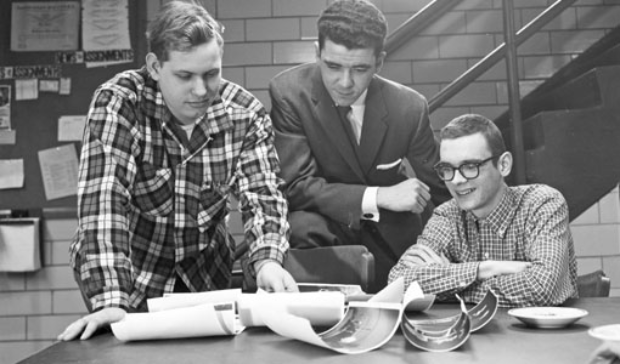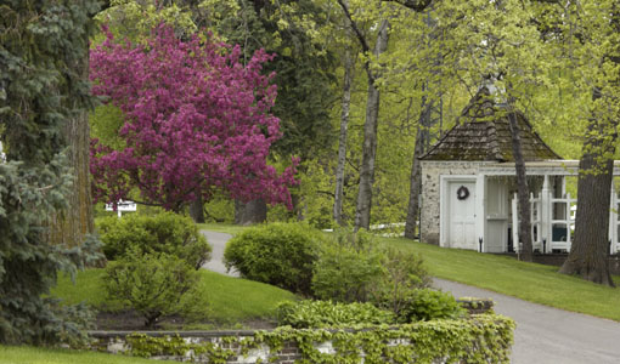It came to me one afternoon in English class, where I was revisiting Hemingway and Fitzgerald in the company of St. Thomas undergraduates, that I was actually sitting atop Tom Town, a mixture of surplus World War II buildings that marked the campus during my undergraduate days a half century ago.
Where O'Shaughnessy Educational Center and O'Shaughnessy-Frey Library Center now stand was once a neighborhood of some 20 double-dwelling huts housing faculty and married veterans, as well as three two-story frame barracks, all courtesy of the postwar largesse of the federal government. It was during an evening in one of these faculty huts, for which the word "humble" would be inadequate, that English professor Herbert Slusser talked me into coming to St. Thomas while his wife did dishes a few feet away. In one of the barracks, I took Air Force ROTC classes and edited a yearbook. In another, the infamous "Grill," we students ate lunch, lit after-meal cigarettes and played bridge, sometimes through our next class.
By today's standards, Tom Town would be a blighted village, but in a curious way it was the heart of the St. Thomas I attended from 1954 to 1958, though it was even then on its last legs as land was cleared for the library and a new student commons. By the time I returned to the college to run the news bureau and teach journalism from 1962 to 1967, Tom Town was already a distant memory for an institution described by the Ford Foundation as "a regional center of excellence." I've always thought there ought to have been a plaque somewhere.
It is strange re-entering a campus after so many years. Things are not where they are supposed to be. The President's Office is still where it has always been in Aquinas Hall, but across the corridor where veteran-students used to bring their problems, there is now an elevator. I could not get into the old Aquin office; the door on the north side of the old Albertus Magnus Hall was locked. I peered wistfully through a window.
I was editorial page editor of the campus newspaper for two-and-a-half years, starting the second semester of my freshman year, and editor-in-chief my senior year. A commuter student, I spent more time in the Aquin office than any resident student spent in his dorm room. We often worked until 1 or 2 a.m. making up the paper. I recall the seasons at night as I dropped pages off at the printer - the acrid air of fall, the moonlight-on-snow of winter, the scent of lilacs in spring. The building has been completely renovated as the John R. Roach Center for the Liberal Arts, and the Psychology Department has taken over the old Aquin area, oblivious, I am sure, to the generations of ink-stained wretches who toiled there.
(A brief aside about the Psychology Department. When I requested a copy of my academic transcript in preparation for this article, the Registrar's Office had me down as an English major. I had always thought I had accumulated enough credits for a second major in psychology, so I appealed to the registrar. He passed it on to an academic committee that handles such things, and after a forensic study that took a couple of months, the committee instructed the registrar to award me a second major, 48 years after the fact. It was important to me that I not be guilty of resume fraud all these years.)
Many memories lurk behind the Mankato stone, at least one not pleasant. When I pass O'Shaughnessy Hall, I always recall the evening I lay blindfolded on a bed of ice in a locker room during a Tiger Club initiation ceremony. Someone pointed what he thought was an empty starter's gun at my face and pulled the trigger. It wasn't empty. After painstakingly removing the powder burns from my jaw, my family physician called Monsignor James P. Shannon, the college's president. It was the last such Tiger Club initiation.
The Aquin now occupies better digs in Murray-Herrick Campus Center, and the English Department has long since decamped from its large room, dotted with desks, on third-floor Aquinas. St. Thomas Military Academy has departed the campus for the suburbs, and there is artificial turf in O'Shaughnessy Stadium. Architects have done a masterly job in shoehorning new buildings into the original campus, although at times a former student feels a little cramped by infill construction.
The campus has not only crept across Summit Avenue to incorporate the St. Paul Seminary and its desirable land, but it also has a gleaming educational footprint in downtown Minneapolis. When I was on the staff of the college in the 1960s, it was considered a daring move across the Mississippi to have a Christmas reception in Minneapolis for graduates working there.
One day on the way to my class last spring I paused on the fringe of a student rally in favor of diversity. I can't remember that we rallied for anything in the 1950s. The closest we came to recognizing the concept of diversity was an annual Irish versus the World basketball game, the winner taking control of a beer keg, painted half green and half orange. Yet, Mr. Tommy in my graduation year was black, although we never would have called him that.
I came to St. Thomas with close friends Terence Doyle, Daniel Shea and Edward Staab, with whom I had been educated from parochial school kindergarten through Minneapolis De La Salle High School. Our cohort (with the addition of transfer Richard Rodney) went on to earn six post-baccalaureate degrees on the way to careers in medicine, law and higher education, and respect for our undergraduate education at St. Thomas runs deep.
The most striking change on campus is, of course, the presence of women, and, to a lesser degree, cell phones and bottled water. In fact, they seem to go together. There were occasional female students in my all-male St. Thomas, due to cooperative programs with St. Catherine's and (coed) Twin Cities private colleges. (I took a couple of classes at St. Catherine myself.) The faculty looked no different than the student body, with only a handful of female professors.
St. Thomas' decision to educate the other half of the human race is a decided plus. One area heavily influenced by the presence of women is the musical arts. In my day, the apex of campus musical performance was typified by "The Tomcats," a jazz combo that had a well-deserved regional reputation. The college's official band and choral groups, standard on most all-male Catholic campuses, were adequate but a far cry from today's sophisticated smorgasbord of musical arts offered, for example, in the annual Christmas concert in the campus chapel.
Slowly but surely the faculty became gender-integrated, another educational positive. When I decided to take advantage of St. Thomas' generous policy of senior citizen access to educational offerings, the English course that caught my eye was taught by Dr. Kelli Larson. I was later to learn that she was in her 16th year of teaching at St. Thomas and an avowed fan of Ernest Hemingway, despite the misogyny which has led a few female professors to decline to teach him. My favorite author, F. Scott Fitzgerald, was part of the course package, and so I ended up in Room 314 OEC for an hour and 40 minutes on Tuesdays and Thursdays last spring, along with 18 undergraduates who probably wondered about the older chap sitting among them.
I never missed a class and I never looked at my watch. The pedagogy was different from what I experienced as an undergraduate. The teaching style then was largely lecture, with some Socratic dialogue. It was an era English majors of the time like to think of as the Golden Age, with Herbert Slusser and James J. Colwell as iconic professors with diametrically opposed personalities. In contrast, Larson emphasized collaborative textual analysis, as well as individual oral class presentation, in addition to the usual lectures by the professor and written essays by students.
Her approach often was inventive. For example, one day the class was broken into small groups and told to imagine hosting a dinner party with three tables, five at a table. They could invite any character from the six novels and six short stories we had read, but they had to specify a seating arrangement and explain why they placed various persons where they did. Another time, close reading of the text was competitively rewarded in a rip off of television's "Jeopardy." These were not fun-and-games, but effective ways of engaging young men and women, nursed in an audiovisual-digital age, in the serious task of discerning how words describe the human condition.
At the beginning, I was reluctant to talk much, lest I interfere with the natural flow of discussion among students 50 years younger than me. I simply enjoyed meeting again two authors I had not seriously read for more than four decades. I relished anew Fitzgerald's romantic lyricism in The Great Gatsby, as well as the stiff-upper-lip nihilism in Hemingway's "A Clean, Well-Lighted Place."Although I had a graduate degree in American literature, I learned from listening to my fellow students, who took to Hemingway and Fitzgerald well.
Toward the end of the course, I volunteered to put together a car tour of four Fitzgerald-related sites in St. Paul's Cathedral Hill neighborhood. The class posed on the steps of 599 Summit Ave., where Fitzgerald completed his first novel and stopped cars in the street to tell people it was going to be published. Larson later gave each student a copy of the photo. Someday, they will look at a scrapbook and wonder who the white-haired guy is.
After my first class meeting, I was in the Bookstore buying the assigned Hemingway and Fitzgerald writings for my own library. (My bill was $47.95; the woman ahead of me paid 10 times that for course materials in what looked like science or engineering.) A woman member of my class in line behind me asked politely what I was doing in English 390. "I'm a 'senior citizen audit,' " I explained. She paused and then replied, "I hope to be one of those someday."
When I left St. Thomas it was a family business. When I returned, it was a corporation. I went to a Catholic liberal arts college. I came back to the largest private university in Minnesota. The entrepreneurial vision of St. Thomas' leadership has created a successful and prosperous institution, present and influential in the community and church in a way few in Tom Town would ever have imagined.
But I still think there ought to be a plaque.
Richard Conklin '58 retired in 2001 as associate vice president for university relations at the University of Notre Dame. He and his wife live in the Twin Cities. He took his recent class through the Center for Senior Citizens' Education; adults age 55 or older can audit a wide variety of undergraduate courses on a space-available basis. Usually about 150 people do so each semester.







